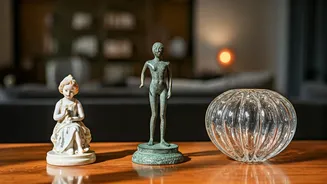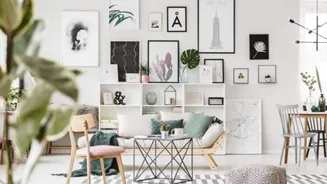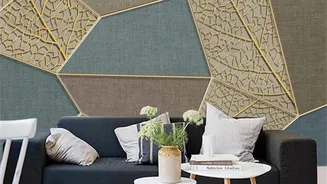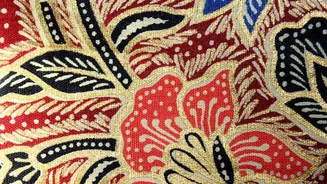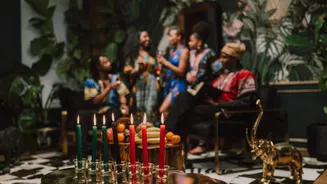Choosing the Right Pieces
Selecting the appropriate vintage furniture involves a thoughtful blend of personal taste, space considerations, and an eye for quality. Begin by evaluating
your home's existing style. Do you lean towards modern minimalism, cozy traditional, or eclectic bohemian? The selected furniture pieces should complement, not clash, with your current décor. Assess the available space. A large, ornate antique cabinet might overwhelm a small room, while a petite side table could easily fit in a compact space. Consider the functionality of the furniture. Is it a purely decorative item, or will it serve a practical purpose? Ensure the piece is structurally sound. Check for loose joints, wobbling legs, and other signs of wear and tear. A bit of character is desirable, but extensive damage can be problematic. Research the materials used. Solid wood pieces, for instance, are often more durable and valuable than those made from particleboard or veneer. Pay attention to the details. Look for craftsmanship elements like dovetail joints, hand-carved details, or unique hardware. These details are indicative of quality and can add to the charm of the piece.
Mixing Old with New
Integrating vintage furniture with modern décor is about striking a balance. Avoid creating a museum-like atmosphere; instead, aim for a cohesive blend of old and new. A key principle is contrast. A sleek, contemporary sofa can be beautifully complemented by a vintage coffee table or an antique side chair. This creates visual interest and prevents the space from appearing overly curated or stuffy. Use the layering technique. Start with a neutral base, such as light-colored walls and modern furniture, and then introduce vintage pieces as accent elements. This approach prevents the vintage furniture from dominating the space. Experiment with textures. Pair the smooth lines of modern pieces with the textured surfaces of vintage furniture, such as a velvet armchair or a distressed wooden chest. Incorporate accessories. Place vintage lamps, artwork, or decorative objects strategically throughout the space to tie the old and new elements together. Be mindful of color palettes. Choose colors that work well together. Consider a neutral background with pops of color from vintage pieces or a cohesive color story to prevent visual clutter. Embrace the unexpected. Don't be afraid to mix different styles and eras. A mid-century modern credenza can look fantastic in a Victorian-era space, provided it's balanced with other elements.
Placement and Arrangement
The placement and arrangement of vintage furniture significantly impact the overall look and feel of your home. Consider the room's focal points. Is there a fireplace, a large window, or a particular architectural feature that draws the eye? Arrange your vintage furniture to complement these focal points. Create conversation areas. Group furniture in a way that encourages interaction and conversation. A vintage sofa, paired with a couple of armchairs and a coffee table, can create a cozy and inviting seating area. Pay attention to traffic flow. Ensure that the furniture arrangement allows for easy movement throughout the room. Avoid blocking doorways or pathways. Think about scale and proportion. Ensure the size of the vintage furniture is appropriate for the room. A large antique dining table can be overwhelming in a small dining room, while a petite writing desk might get lost in a spacious office. Use rugs to define spaces and anchor furniture. A vintage rug can provide a focal point and tie different pieces together. Consider the light. Place furniture in areas with good natural light to highlight its features. A vintage desk or vanity can be positioned near a window to take advantage of the light.
Caring for Your Pieces
Proper care and maintenance are crucial to preserve the beauty and longevity of your vintage furniture. Regularly dust and clean your furniture. Use a soft cloth or a vacuum cleaner with a brush attachment to remove dust and debris. Avoid harsh chemicals and abrasive cleaners, which can damage the finish. For wooden furniture, use appropriate wood cleaners and polishes to protect the surface and enhance its luster. Be mindful of sunlight exposure. Prolonged exposure to direct sunlight can fade the colors and damage the finish of your furniture. Position furniture away from direct sunlight or use window treatments to filter the light. Protect furniture from moisture and spills. Use coasters for drinks and placemats for dining. Clean up spills immediately to prevent staining and damage. If the furniture is exposed to significant moisture, ensure it dries completely to prevent mold and mildew. Consider professional restoration. For furniture with significant damage, consider consulting a professional furniture restorer. They have the expertise and tools to repair and restore vintage pieces to their original condition. Periodically inspect your furniture. Check for loose joints, scratches, or other signs of wear and tear. Address these issues promptly to prevent further damage. Rotate furniture. Rotate cushions and pillows regularly to ensure even wear and tear and extend the life of your furniture.
Sourcing Vintage Treasures
Finding vintage furniture involves exploring different avenues and being prepared to invest time and effort. Antique shops and vintage stores are traditional sources for finding unique pieces. Explore local shops and check for estate sales and auctions. These locations often have a wide selection of vintage furniture at competitive prices. Flea markets and garage sales offer opportunities for discovering hidden gems at bargain prices. Be prepared to haggle and examine the pieces carefully before making a purchase. Online marketplaces, such as eBay, Etsy, and Craigslist, provide a vast selection of vintage furniture from sellers around the world. Use search terms, filter by location, and check the seller's ratings. Consider consignment shops. These shops sell furniture on behalf of others, offering a curated selection of vintage pieces. Research the piece before buying. Learn about different styles, periods, and designers to identify valuable pieces and avoid counterfeits. Be patient. Finding the perfect vintage piece can take time. Don't rush the process; explore different sources, and be prepared to wait for the right item. Consider the condition of the piece. Look for pieces in good condition or those that can be easily restored. Set a budget. Determine how much you are willing to spend before you start shopping to avoid overspending.


